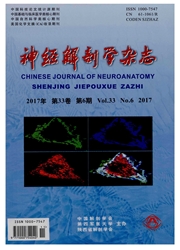

 中文摘要:
中文摘要:
目的:建立在外周伤害性感受器特异性表达GCaMP6f蛋白的方法,并在疼痛刺激条件下,应用钙成像技术实时监测小鼠伤害性感受神经元的细胞内钙活动。方法:包装并纯化rAAV2/9-CAG—DIO—GCamp6f病毒,并通过立体定位注射该病毒于SNS—Cre小鼠L4/L5背根神经节(dorsal root ganglion,DRG)内。动物存活3—4周,然后制备L4/L5整节DRG标本,检测GCaMP6f蛋白表达情况,并观察疼痛刺激条件下诱致的伤害性DRG神经元的钙反应情况。结果:SNS—Cre小鼠L4/L5DRG内注射rAAV2/9-CAG—DIO—GCamp6f病毒后,荧光显微镜观察显示GCamp6f病毒特异性地表达在中、小型的DRG神经元。给予DRG神经元高钾刺激(KC130mmol/L)可以诱致神经元胞内的钙离子水平显著上升。进一步给予伤害性DRG神经元特异性标志物TRPV1受体的激动剂Capsaicin(1μmol/L),结果显示其可以诱致GCamp6f蛋白标记的DRG神经元呈现显著的钙反应。结论:本研究建立的SNS—Cre小鼠DRG在体注射rAAV2/9-CAG—DIO—GCamp6f病毒特异性标记伤害性DRG神经元的方法是成功的,该方法的成功建立对于活体特异性监测伤害性DRG神经元的功能活动提供了重要工具。
 英文摘要:
英文摘要:
Objective : To establish the methods for in vivo GCaMP6f expression specifically in nociceptor neurons and to measure the Real-time intracellular calcium response by using calcium imaging techniques. Methods: Vectors of rAAV2/9-CAG-DIO-GCamp6f virus were constructed and were stereotaxically injected into unilateral L4/L5 dorsal root ganglion (DRG) of SNS-Cre mice. Mice were allowed to survive for 3-4 weeks. After that, intact whole mount L4/L5 DRGs preparation from injected mice was made. The expression of GCaMP6f virus in DRG neurons was assessed and intracellular calcium response to painful stimuli was measured. Results : After rAAV2/9-CAG-DIO-GCamp6f virus injection into L4/L5 DRGs in SNS-Cre mice, live imaging experiments demonstrated that GCamP6f virus was mainly expressed in small-to medium-diameter nociceptive DRG neurons in SNS-Cre mice. Bath application of high potassium ( KCL 30 mmol/L) could induce a significant calcium increase in GCaMP6f-expressing DRG neurons. Delivery of capsaicin ( 1 μmol/L) , an agonist of TRPV1 which is a marker for nociceptive DRG neurons, caused a dramatic calcium response as well. Conclusions : We have successfully established the methods for in vivo injection of rAAV2/9-CAG-DIO-GCamp6f in nociceptive DRG neurons of SNS-Cre mice. This provides a useful tool to specifically monitor the functional activity of nociceptors nociceptive DRG neurons in vivo.
 同期刊论文项目
同期刊论文项目
 同项目期刊论文
同项目期刊论文
 期刊信息
期刊信息
